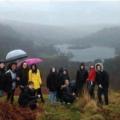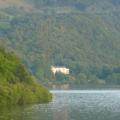News topics
Monthly Newsletters
// //// //// Online Booking //
// //// // // // // // //
For group bookings please contact
017687 77246 or
contact@derwentwater.org
David Parker, 3rd Gateshead Boys Brigade, April 2019
February 2017

In 1802, on the first Thursday in February, it was ‘a terribly wet day’ in Grasmere, and Dorothy Wordsworth was ‘very sick’ and ‘lay down as soon as breakfast was over’, while her brother William ‘thought a little about The Pedlar’, tiring himself out and sleeping badly. However, despite rainy and snowy days that month, the Wordsworths still walked frequently to Rydal for letters, as well as 'walking backwards and forwards' most days, composing and altering poems.
215 years later it was a ‘rainy morning’ (according to my diary and the keen observations of 55 English Literature students from London), but as soon as breakfast was over we boarded a coach and travelled down to Grasmere, ready to walk to Rydal and White Moss Common along the Wordsworths’ favourite paths. We read sections of The Pedlar and other poems, and compared Dorothy Wordsworth’s journal entries with our modern-day week.
In the morning the Year 13 students looked around Dove Cottage (home to the Wordsworths from 1799 to 1808) and did an Introduction to Romanticism workshop with the Wordsworth Trust Education Officer, while I took the Year 12 students for a walk to John’s Grove, White Moss Common, White Moss Tarn, and Grasmere village. Then we swopped over at lunchtime and I took the Year 13 students for a walk to Rydal Mount (William Wordsworth's home from 1813 until his death in 1850).
On the way to Rydal is White Moss Common, a wild boggy hill with views of Rydal Water and Grasmere, and on the side of the common, overlooking Grasmere, is John’s Grove, named by William and Dorothy after their brother John (a sailor who, ‘by pacing here, unwearied and alone’, wore a path through the grove, like a sailor who paces the deck of his vessel. Quote from The Fir Grove by William Wordsworth).
It was along these paths, in light gusts of rain, that I walked with the Chestnut Grove students, reading from Dorothy Wordsworth’s journal and stopping at points that inspired poems like The Leech Gatherer/Resolution and Independence (White Moss Tarn); The Waterfall and the Eglantine, The Oak and the Broom, and To the Clouds (all on the coffin-route path to Rydal); and The Fir Grove, The Sailor’s Mother, and Beggars (all near John’s Grove). We also walked to Grasmere village to see St Oswald’s Church, where a man came up to me and said that his great grandmother had been in the choir at William Wordsworth’s funeral; the Wordsworth family graves; the rectory where William, his wife Mary, and Dorothy lived from May 1811 to May 1813; and the famous gingerbread shop.
It was a pleasure to accompany the sixth formers on their trip to Grasmere, particularly as most of the students had not been to the Lake District before. The rest of the week consisted of classes in the hostel, led by the Chestnut Grove English teachers, and some quizzes and group poetry performances, as well as some short walks to the lake and Ashness Bridge. The students worked really hard, and I was very encouraged by their enthusiasm and camaraderie: I hope we get more English Literature groups like this! (Katy Moore, DIH staff member. All quotes from The Grasmere Journals by Dorothy Wordsworth).
Here are some extracts from Dorothy Wordsworth’s Grasmere Journals that seemed fitting for our damp but enlivening day in Grasmere:
Monday 16th November 1801. A very dankish misty wettish morning... Mrs O observed that it was beautiful even in winter! We walked backwards and forwards in the church field.
Sunday 13th June 1802. …There was a shower which drove us into John’s Grove before we had quitted our favourite path.
Tuesday 5th July 1802. It was a very rainy day but in the afternoon it cleared up a little and we set off towards Rydale to go for letters. The rain met us at the top of the White Moss and it came on very heavily afterwards. It drove past Nab Scar in a substantial shape, as if going Grasmere-wards as fast as it could go… We walked backwards and forwards on the White Moss path, there was a sky-like white brightness on the lake…Glow worms out, but not so numerous as last night. O beautiful place!
Wednesday 3rd February 1802. A rainy morning. We walked to Rydal for letters, found one from Mrs Cookson and Mary H. It snowed upon the hills. We sate down on the wall at the foot of White Moss. Sate by the fire in the evening. William tired and did not compose. He went to bed soon and could not sleep.
The 55 English Literature students and 4 teachers from Chestnut Grove Academy Sixth Form (South London) stayed with us for 3 nights, travelling by train from London to Penrith. The Year 13 students are studying The Romantic Period for the Poetry Component of the new Edexcel A Level specification and so they were interested to learn about the Romantic poets who visited or lived in the Lake District. The residential was subsidised by our DIH Fund, with free activities and resources from Katy. Here is a link to their school newsletter, with some lovely photos: http://fluencycontent2-

Many of you will be familiar with Ashness Bridge, just above the top of our grounds. The bridge spans the beck which flows down past the hostel, and it is one of the most popular spots in the Lake District, particularly for photographers.
The National Trust is keen to establish the chronology of change in both the physical setting and the cultural context of this famous landmark in Borrowdale. Work will involve research in a range of primary and secondary source material, utilising 18th and 19th century topographical art, historic photography and mapping, as well as field work, establishing baseline photography and using GIS mapping. The outcomes of this research, aided by Lancaster University History MA students, will help inform the long-term management of planting and views from the Ashness Bridge area, contributing to the National Trust Sustainable Landscape Plan.
The view includes the trees in our grounds, which have grown considerably over the past 200 years, and so we are involved in the project, with Tim recently meeting National Trust Lake District Curator Harvey Wilkinson, walking up through our grounds to the bridge. We are also interested in your views about iconic landmarks and viewpoints: should particular views be preserved/restored, and if so to which period in time? Have you made paintings or photographs of the view from Ashness Bridge that you would like to share with us?
Email us at reception@derwentwater.org if you would like to share any comments or images relating to Ashness Bridge, and we will keep you updated about the project.

The new exhibition at Keswick Museum presents a really interesting combination of historical and present-day climbing photography, focusing on the Keswick-based brothers George and Ashley Abraham, and contemporary photographer Henry Iddon.
The Abraham brothers began climbing in Keswick in the 1890s using their mother’s washing line! Having met Owen Glynne Jones and other celebrated climbers in the Lakes at that time, they went on to become respected climbers themselves, discovering many new routes here and in Scotland and Europe. They were also unique in capturing those early exploits using massive glass plate cameras which they hauled on to the fells and operated in difficult conditions.
This exhibition celebrates their work with a range of their iconic climbing photographs and some of the well loved views they popularised and which are still admired today. It accompanies Henry Iddon’s exhibition of photographs taken in 2016 with the same Instanto camera, and featuring contemporary celebrated climbers.
The exhibition runs until 12th May 2017 and there are special activities for families in school holidays. http://

There have been lots of exciting deliveries this winter - so many cardboard boxes! The contents include a data projector, a wall-mounted flat screen TV, new bedding, a 7ft Christmas tree, a log store (well-built by Pez and Ian), and shiny new laundry baskets... Tim and Nicola also hauled 35 new mattresses around the hostel - we hope they help you to sleep well! We are also introducing a few new items on the menu, and in the next few months the servery and reception area will be refurbished.





